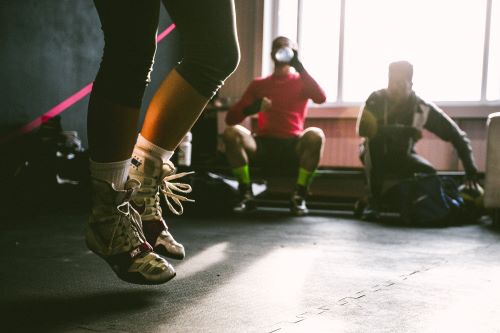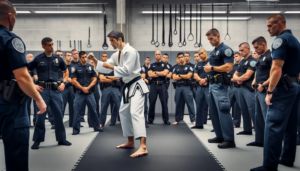
Are you wondering why boxers jump rope?
In this article, we’ll go through 8 reasons why boxers jump rope and have done for many centuries.
Although the article’s focused on boxers, it also answers:
- Why do MMA fighters jump rope?
- Why do Muay Thai fighters jump rope?
Essentially, the benefits of jump rope apply to all combat sports athletes, including MMA fighters, Muay Thai, kickboxers, boxers, and more.
Contents
Why Do Boxers Jump Rope?
Boxers jump rope because it mimics a fight, is low-impact, and improves conditioning, cardiovascular endurance, footwork, coordination, speed, explosiveness, balance, timing, rhythm, focus, mindfulness, and mental toughness – all benefits greatly improving a boxer’s performance.
More clearly, boxers jump rope for the following 8 reasons:
- Mimics a Real Fight
- Conditioning and Cardiovascular Endurance
- Low Impact (Reduced Injury Risk)
- Footwork and Coordination
- Speed and Explosiveness
- Weight Loss
- Focus, Mindfulness, and Mental Toughness
- Simplicity and Convenience
Let’s explore each of the 8 reasons why boxers jump rope.
1. Mimics a Real Fight
The main reason boxers jump rope is because it mimics a real fight.
The footwork used, the coordination, the speed, and being light on the feet when jumping rope is practically the same as when in a boxing match.
The sport-specific nature of jump rope is what makes it as good as if not better than shadowboxing for boxers.
2. Conditioning and Cardiovascular Endurance

Boxers also jump rope to improve their conditioning and cardiovascular endurance.
Boxers must be able to expend and maintain high amounts of energy over long periods for optimal performance (conditioning).
Most major boxing fights are either 10 or 12 three-minute rounds which is a total fight time of 30 or 36 minutes.
This is a very long time to be fighting, so boxers jump rope to improve their cardiovascular endurance and match it to their upcoming fight length.
They may do 3 minutes of medium to high-intensity followed by a one-minute break, 10 or 12 times. If their upcoming fight is only 8 rounds, then they’ll jump rope for 8 rounds and up the intensity.
Jumping rope is also great because the intensity can be changed to meet the boxer’s desired conditioning needs and strategy.
If they’re expecting a longer slow-paced fight they can focus on lower intensity. But if their strategy is to take their opponent out quickly, they can focus on maximum intensity to condition themself to perform optimally in short spurts.
However, with both strategies, a boxer must always condition themselves to maintain maximum power, explosiveness, and cardiovascular endurance throughout the fight.
Boxers can change the jump rope for different needs, often using speed ropes for high-intensity training and weighted ropes for cardio workouts.
Speed ropes are lighter and are better for speed and coordination, and weighted ropes for conditioning and cardiovascular and muscular endurance.
Overall, boxers jump rope because it’s the most sport-specific cardiovascular exercise they can do alongside shadowboxing.
3. Low Impact (Reduced Injury Risk)
Boxers also jump rope because it’s a very low-impact exercise.
This makes it extremely useful when a boxer’s injured and can’t run or do another high-impact exercise.
Boxers also jump rope at the end of their fight camp and in the last few weeks before a fight because they can reap all of the benefits it offers, while ensuring they avoid injury and enter the fight in optimal condition.
Jump rope is a great exercise to pair with a heavy weightlifting day because it allows the muscles and joints time to recover.
Boxers wouldn’t want to run after a heavy squat session because it’s too much impact for their knees and ankles – but they can jump rope.
The low-impact nature of jump rope also makes it a perfect warm-up exercise before high-intensity training such as sprints, sparring, or heavy weightlifting.
It allows boxers to get sufficient blood flow throughout their body and helps them avoid injury by warming up their joints and muscles. It’s a smart way to stay active without overtaxing the body.
4. Footwork and Coordination

Jumping rope enhances footwork, agility, and coordination of the whole body, enabling boxers to dance around their opponent, maintain balance, evade punches, and throw punch combinations from various angles.
Great footwork underpins powerful punches as it provides a solid base, and it also improves rhythm and timing. Great footwork is foundational to a boxer’s performance and it must be continually worked and improved upon.
Various jump rope techniques such as the boxer’s skip, the boxer’s heel-toe step, regular bounce, run in place, alternating single-foot rope jumping, and fast skip are designed to enhance footwork, balance, and coordination.
The boxer’s skip is of course the most utilized technique. This method is designed to mimic the footwork used during a fight, where the weight is slightly shifted from one foot to another with each jump.
The boxer’s skip promotes energy efficiency as it teaches boxers to have smoother and lighter movements.
The various jump rope techniques can transfer into the ring, making jump rope an effective tool for improving boxing-specific movements and different patterns of footwork.
Boxers condition themselves through jump rope and great footwork becomes second nature when fighting.
5. Speed and Explosiveness
Jumping rope is a form of plyometric exercise, which is known to enhance speed, strength, and explosiveness.
The faster a boxer can move and react, and the more explosiveness in their punches, the better their performance in the ring.
The split-second decisions required to keep the rope moving translate into faster reflexes in the ring.
This speed and reaction time give boxers an edge, allowing them to respond quickly to their opponent’s moves and also beat them to the punch.
The explosive movements involved in jumping rope help improve reactive strength and explosiveness, making boxers more efficient in delivering punches and evading hits.
Boxers use techniques like single-arm side swings, double-unders, front straddle, side straddle, front-to-back, and crossovers to further improve speed and explosiveness.
All of these movements train the fast-twitch muscles (especially in the calves) and help boxers to be especially explosive through the heels of their feet – resulting in punches thrown with optimal power.
6. Weight Loss

Jumping rope is a highly effective exercise for weight loss, with the potential to burn between 15 to 20 calories per minute at a moderate to high intensity, which equals 225 to 300 calories in just 15 minutes.
Jumping rope at a medium to high intensity is very similar to running in terms of calories burned.
Calorie burning is important for boxers as they must cut weight before a fight to make sure they don’t weigh above the upper limit of their contracted weight class.
The number of calories burned during a jump rope workout is influenced by factors such as the individual’s weight, the speed and intensity of jumping, and the length of the workout.
Increasing the intensity of the workout by increasing speed and incorporating variations like double jumps and higher jumps can boost the calorie burn and engage different muscles.
No matter the variations used, jump rope engages various muscle groups including the arms, shoulders, legs, and core.
It’s a fun and engaging way for boxers to shed those extra pounds and stay in fighting shape – with minimal risk of injury before a fight.
7. Focus, Mindfulness, and Mental Toughness
Boxing is as much a mental game as it is physical, and jumping rope is a tool used by boxers to build mental toughness and sharpen focus.
The repetitive motion requires long periods of focus to evade the rope. It’s not easy to maintain rhythm and coordination while jumping rope, especially when fatigue sets in.
Some boxers and Muay Thai fighters train barefoot with a steel cable jump rope because it hurts when it hits the feet – and this greatly sharpens focus.
Mental toughness is greatly improved when a boxer jumps rope and pushes past what they thought was their current limit. This may be jumping rope for a longer period, at a higher intensity, or both.
Building mental toughness is crucial for boxers, where the ability to persevere through physical challenges can often be the difference between winning and losing in the ring.
Jumping rope can also serve as a stress reliever. The rhythmic motion and focus required provides a meditative effect, helping boxers clear their minds, stay centered, let go of prior stress, and prepare themselves for the fight ahead.
8. Simplicity and Convenience
Boxers also jump rope because it’s simple and convenient.
They can get a great workout without the need to go to the gym, which can be time-consuming and difficult if they’re traveling or away from home and not obeying their timetable.
Jump rope is very convenient because it can be performed anywhere as long as some space and a rope are handy.
This kind of convenience also makes jump rope extremely time efficient, allowing boxers more time to improve other essentials.
The Bottom Line
So, ‘why do boxers jump rope?’
Boxers jump rope because it has many brilliant benefits which improve their performance in the ring.
Jumping rope mimics a real fight, is low-impact, and improves conditioning, cardiovascular endurance, footwork, coordination, speed, explosiveness, balance, timing, rhythm, focus, mindfulness, and mental toughness.
With so many performance benefits, it’s no surprise boxers have utilized jump rope for centuries.
Sonny Liston was one of the first commercialized boxers to popularize jump rope during his career in the 1950s and 60s, which continued with the likes of Muhammad Ali and Mike Tyson.




